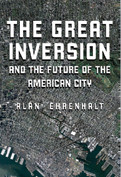
The Great Inversion and the Future of the American City
Alan Ehrenhalt
276 pages, Alfred A. Knopf, 2012
Imagine The New York Daily News blaring the headline: “Obama to Levittown: Drop Dead.” In the mid-1970s, of course, it was President Ford who was alleged to have written off New York City. The famous headline was only partially shocking—American cities in the 1970s were a mess, hemorrhaging jobs, people, fiscal integrity, and hope. The streets were grimy, crime was epidemic, and fear was in the air.
How times have changed. Manhattan is thriving. Crime is at record lows, and “inner cities” in San Francisco, Chicago, Los Angeles, and Boston are vital. Meanwhile, many a suburb is hemorrhaging. Vacant homes dot the suburban landscape of the subprime mortgage crisis, and poverty is growing. Suburbs are increasingly seen as culturally stale and boring, especially for those who will define the future—the young.
The Daily News trumpeting the end of the suburb is not likely, but it is imaginable after reading Alan Ehrenhalt’s interesting new book, The Great Inversion and the Future of the American City. Written in an engaging style for a general audience, he argues that US cities have turned tables on the suburbs and are becoming like Paris. Central cities are increasingly where wealth and the educated elite are concentrating, while poverty and racial minorities are being pushed to the inner-ring suburbs. The fates of cities and suburbs have thus been reversed through a process of demographic inversion that inspired the book’s title.
The Great Inversion makes its case through examples, taking the reader on a tour of places like Sheffield in Chicago, Houston’s Third Ward, Center City in Philadelphia, and downtown Phoenix. Ehrenhalt brings these neighborhoods alive through evocative description, and census statistics are used to buttress his argument. Ehrenhalt grew up in Chicago, where he begins his first major example in the Sheffield neighborhood north of the Loop. He argues that although Sheffield was down and out in the 1970s, today it is “inverted”—brimming with telltale signs of gentrification such as boutiques, fashionable restaurants, yuppies, and high home prices.
Sheffield Park was never a classic “slum,” however, a fact that complicates Ehrenhalt’s narrative. Sheffield sits in the larger community of Lincoln Park, a high-status area that hugs Lake Michigan near the Gold Coast. In 1970, Lincoln Park was less than 10 percent black and only 12 percent of families lived in poverty. It was nothing like the deeply stigmatized and predominantly black communities of Chicago located further southwest or on the South Side and with at least double the poverty rate. Sheffield is also home to DePaul University. Few neighborhoods have such institutional bulwarks. And although foreign-born and black migration to the suburbs is on the rise, non-Hispanic whites are a minority of Chicago’s population and have been for several decades.
The general point is that neighborhoods are not islands but are situated in a larger context of spatial inequality that is remarkably durable. If we take the poverty rate of a neighborhood at any point in time, for example, we can predict quite well its future poverty rate.
Unfortunately, racial segregation also continues to be part of the United States’ persistent spatial divisions and a driver of neighborhood social hierarchies. To be sure, cities like New York that have always attracted the young have undergone eye-popping change in selected areas, and Ehrenhalt documents this process beautifully. But the wave of inversion, while real, is limited in scope and largely predictable. Put simply, the vast majority of neighborhoods in American cities do not “trade places.” Instead, concentrated poverty and its opposite, concentrated affluence, are surprisingly persistent, leading to what I have called the “enduring neighborhood effect.”
The longer history of change is instructive here. In 1929, Harvey Zorbaugh wrote a famous study of Chicago called The Gold Coast and the Slum. The Gold Coast still exists, and his slum was the area that later became the infamous Cabrini-Green housing projects. The Gold Coast just got richer, and although the slum changed its demographic composition from white to black, it remained a slum for more than 75 years and is now in transition. This points out both the strengths and weaknesses of Ehrenhalt’s thesis. Cabrini-Green likely will be completely gentrified and (re)inverted in the near future given its proximity to the Gold Coast, but its recent trajectory was triggered by a public policy of unusual magnitude—the government teardown of thousands of public housing units. Meanwhile, the Gold Coast of Chicago is as golden as ever, and in other American cities there are few if any places of wealth, or even just plain well-to-do, that are becoming poor. Indeed, when the Gold Coast becomes the slum, that would be a true inversion. What is happening is more like demographic “revision.”
The analytic lesson is that selecting those neighborhoods that do change makes it seem that “radical rearrangement” is more prevalent than it is when we consider all neighborhoods in a city. The same goes for cities as a whole. As Ehrenhalt notes, large swaths of Detroit and St. Louis continue their un-Paris-like decline, similar to many other cities that are off the national radar. Persistent differentiation within and among cities is profound and will continue.
Although the evidence paints a more nuanced and at times contrary picture than Ehrenhalt’s, change is surely afoot, and those interested in the future of the American city would do well to contemplate the important issues he raises. The policy stakes are high; Ehrenhalt’s provocative ideas deserve to be part of the debate.

